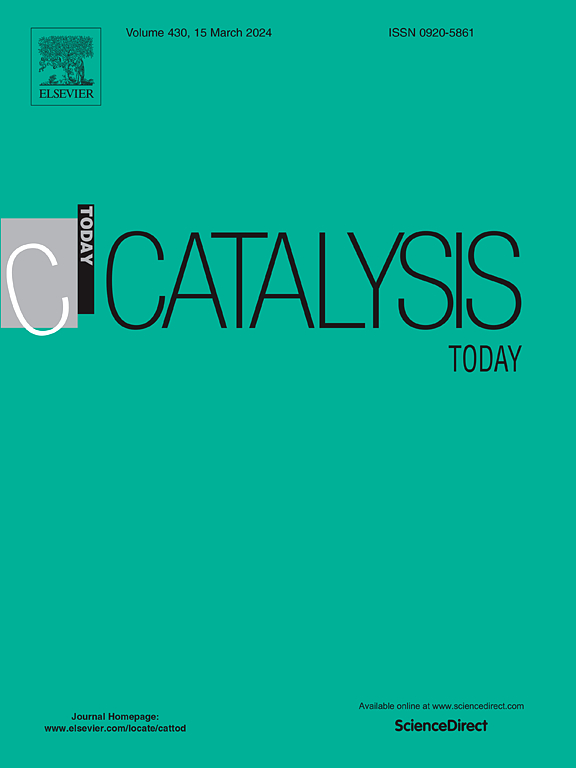Au₂₅簇的结构因素作为合成Au/Nb2O5用于低温CO氧化的前驱体
IF 5.2
2区 化学
Q1 CHEMISTRY, APPLIED
引用次数: 0
摘要
金(Au)催化剂作为一氧化碳(CO)低温氧化的有效材料,其电子结构和几何结构对氧化性能起着关键的调节作用,受到了广泛的关注。以性质明确的Au簇(Au25(SC12H25)18)为前驱体制备了一系列Au催化剂,考察了Au纳米颗粒的尺寸、配体去除率、Auδ+/Au0的比例等结构因素对催化剂CO氧化活性的影响。这项工作揭示了适当去除配体可以提高CO氧化的催化性能。此外,在Au25(SC12H25)18为前驱体的Au/Nb2O5催化剂和Aun(SC12H25)m (m/n = 0.46)为前驱体的Au/Nb2O5催化剂上,Au纳米颗粒的尺寸与CO氧化活性呈负相关,但在具有精确原子前驱体的Au基催化剂上,这种影响更为明显。制备的Au/Nb2O5催化剂在300℃下煅烧,在18℃下具有优异的CO氧化活性(T50 %,温度为50 % CO转化率),这是由于Au纳米颗粒尺寸小,硫醇配体残留最少。我们期望这项研究将激发新的观点,并有助于开发高效和稳定的金基催化剂体系。本文章由计算机程序翻译,如有差异,请以英文原文为准。
Structural factors of Au₂₅ cluster as precursor to synthesize Au/Nb2O5 for low-temperature CO oxidation
Gold (Au) catalysts have gained significant attention as effective materials for the low-temperature oxidation of carbon monoxide (CO), with their electronic and geometric structures playing a key role in regulating oxidative properties. A series of Au catalysts were prepared using well-defined Au clusters (Au25(SC12H25)18) as precursor, and the effects of structural factors on the CO oxidation activity of these catalysts were investigated, including the size of Au nanoparticles, the ligand removal percentage, and the proportion of Auδ+/Au0. This work unveiled that the appropriate removal of ligands can improve the catalytic performance for CO oxidation. Moreover, the size of Au nanoparticles is negative correlation with the CO oxidation activity over Au/Nb2O5 catalysts with Au25(SC12H25)18 as a precursor or on the Au/Nb2O5 catalysts with Aun(SC12H25)m (m/n = 0.46) as a precursor, but the effect was more pronounced in the Au-based catalysts with precise atomic precursors. The prepared Au/Nb2O5 catalyst that was calcined at 300 °C exhibited excellent CO oxidation activity (T50 %, the temperature at 50 % CO conversion) at 18 °C due to the small Au nanoparticle size and minimum residue of thiol ligand. We anticipate that this study will stimulate novel perspectives and contribute to the development of highly efficient and stable Au-based catalyst systems.
求助全文
通过发布文献求助,成功后即可免费获取论文全文。
去求助
来源期刊

Catalysis Today
化学-工程:化工
CiteScore
11.50
自引率
3.80%
发文量
573
审稿时长
2.9 months
期刊介绍:
Catalysis Today focuses on the rapid publication of original invited papers devoted to currently important topics in catalysis and related subjects. The journal only publishes special issues (Proposing a Catalysis Today Special Issue), each of which is supervised by Guest Editors who recruit individual papers and oversee the peer review process. Catalysis Today offers researchers in the field of catalysis in-depth overviews of topical issues.
Both fundamental and applied aspects of catalysis are covered. Subjects such as catalysis of immobilized organometallic and biocatalytic systems are welcome. Subjects related to catalysis such as experimental techniques, adsorption, process technology, synthesis, in situ characterization, computational, theoretical modeling, imaging and others are included if there is a clear relationship to catalysis.
 求助内容:
求助内容: 应助结果提醒方式:
应助结果提醒方式:


